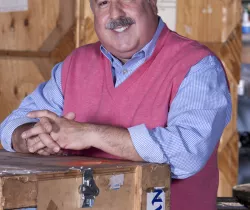Chris Virtuoso

Chris Virtuoso is the National Design Director for MC2, a global company that designs, builds and manages integrated marketing programs for events, exhibits, and brand environments for the world's best brands.

Every year, the industry looks at the latest in exhibit trends – from fabrics to the latest technology. And while incorporating these elements into an experience might help make your brand look modern and cutting-edge, if it doesn’t meet your business and marketing goals, the experience will fall flat.
The fact is, exhibit design trends come and go, but in reality – trends don’t matter to the overall design. Rather it’s your approach to the design and execution of building your exhibit that matters most.
With an exhibit designed and built with a process like a well-oiled, working machine, you’ll hit – and exceed – your goals every time. This process is timeless – built to last.
Creating the machine – the process
As every client is unique, there is no cookie-cutter approach to building a face-to-face brand experience. However, there is a process that, we find, can be applied to every project that we engage in – across client industries as a creative team, we follow these steps.
• The interview. The first step before building any experience is sitting down with all stakeholders – or as many as possible – to ask questions and, most importantly, to listen. We want to understand what the client’s goals are – from a sales, marketing, and business perspective. We listen to what’s being said and also for what’s not being said!
Before going on to the next phase, we make sure our design team understands what was shared and confirm that everyone is on the same page. If you get this step wrong, you’ll waste valuable time making corrections toward the end.
• Discovery phase. With the program goals identified and confirmed, we take them back to the drawing board. We do research – we want to understand the client’s day-to-day world. What issues are they facing? What are their competitors doing? What is important to their daily operations? The more we can do that, the better we can understand their current status in the marketplace. We look at how we can better support what they are doing and identify opportunities unique to their goals and objectives.
• Cross-pollination. One of the key benefits of what we do as exhibit, event and environment designers, is having the opportunity to work with clients across so many different industries. This allows us to bring many different points of view to the table. We’re able to see the similarities – or synergies – that may exist between a project we’ve done for a client in, let’s say, the insurance world to something we’ve done for a client in the automotive industry.
By connecting ideas and audiences that are not obvious, we are able to reframe challenges and think creatively toward a better defined outcome.
• To the drawing board. This is where the real magic happens. We’re able to take what we’ve heard, what we’ve learned, and what we know in order to create something that solves their unique problem—in short, design the best “machine” for the task. Understanding what the client wants to achieve, we take that and consider how that translates into a design. Sometimes we flip the whole idea around – what if we did it this way? The beauty of brainstorming is that nothing is off limits. Yet, within this creative process, it’s important to stay focused.
Editing is a critical part of brainstorming. In order to edit effectively and efficiently, we come up with a word or phrase that becomes the touchstone – or beacon of light – that gives us direction and provides guidance for every choice we make.
In the design world there seems to be an ongoing debate – form vs function. But for an exhibit designer, form always follows function. From an event or a kiosk to a theater or installation, you need to define the function. Any thing that does not serve the function is taken off the table. However, you don’t have to compromise one for the other. The final result always needs to be functional, but at the end of the day, it also has to be beautiful.*
• To the (boardroom) table. Then the moment of truth, we bring our designs to the table. First it’s for account team “buy-in.” Then, after final adjustments, we prepare the final “story” for presentation.
The mission is to deliver an output that accurately addresses the issues and challenges shared in the original presentation. In the beginning of the process, we’re given a specific tool box – logos, products, what they’ve done in the past, what works – and what hasn’t. MC2 takes it and goes through the discovery phase, we explore, and then hand off the next iteration. We may not necessarily return what the client “wants,” but always what they need.
Like a machine — an exhibit, event, or executive briefing center — has to perform. You put all the input in on one end and ROI comes out the other end. This is the overall efficiency rate. If the information is gathered and processed correctly and the desired outcome is defined at the beginning, our experience has shown that this process will deliver the correct results again and again. And, your brand experience will be on target to meet and exceed program goals.
*“When I am working on a problem, I never think about beauty but when I have finished, if the solution is not beautiful, I know it is wrong” – Richard Buckminster “Bucky” Fuller, an American architect, systems theorist, author, designer, and inventor.

Add new comment